
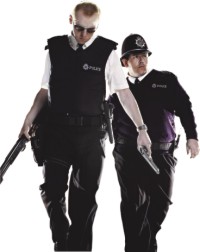 Perhaps the busiest television actor on either side of the pond, British standup comedian-turned-actor Simon Pegg has become a ubiquitous presence to U.K. television viewers since making his debut in the popular 1995 comedy series Six Pairs of Pants. With his role as the writer and hapless title character in the British "zom-rom-com" (zombie romantic comedy) Shaun of the Dead, Pegg's popularity set sail for U.S. shores as well. A Glouchester native who completed his education at Bristol University before segueing into film and television, Pegg showed considerable promise as an actor in his early television appearances. It was during the production of Six Pairs of Pants that Pegg made the acquaintance of future collaborators Jessica Stevenson and Edgar Wright, and in the years that followed, the trio would find notable small-screen success in such efforts as Asylum and Spaced -- with the latter finding an especially strong following on U.K. television. Additional roles in Saturday Live, the outlandish Big Train, and as the lead in Hippies also served to boost Pegg's profile, and in 2001 he joined an impressive cast for a small role in Tom Hanks' acclaimed miniseries Band of Brothers.
Perhaps the busiest television actor on either side of the pond, British standup comedian-turned-actor Simon Pegg has become a ubiquitous presence to U.K. television viewers since making his debut in the popular 1995 comedy series Six Pairs of Pants. With his role as the writer and hapless title character in the British "zom-rom-com" (zombie romantic comedy) Shaun of the Dead, Pegg's popularity set sail for U.S. shores as well. A Glouchester native who completed his education at Bristol University before segueing into film and television, Pegg showed considerable promise as an actor in his early television appearances. It was during the production of Six Pairs of Pants that Pegg made the acquaintance of future collaborators Jessica Stevenson and Edgar Wright, and in the years that followed, the trio would find notable small-screen success in such efforts as Asylum and Spaced -- with the latter finding an especially strong following on U.K. television. Additional roles in Saturday Live, the outlandish Big Train, and as the lead in Hippies also served to boost Pegg's profile, and in 2001 he joined an impressive cast for a small role in Tom Hanks' acclaimed miniseries Band of Brothers.
 Though the majority of Pegg's exposure had been limited to the small screen at the dawn of the new millennium (save for brief appearances in such features as The Parole Officer and 24 Hour Party People), the prolific television comic made a successful leap to the big screen as the writer and eponymous character in 2004's Shaun of the Dead. Cast as a put-upon electronics-store employee who attempts to rescue his friend (played by Pegg real-life best friend and Spaced co-star Nick Frost), mother, and ex-girlfriend as the zombie apocalypse rages around them, Pegg drew big laughs with Shaun, and it wasn't long before the film was scheduled for stateside release. A film championed by the likes of even zombie-genre inventor George A. Romero for its witty writing and cleverly constructed chills, Shaun of the Dead found considerable success when released into stateside theaters in September 2004 (it would come as no surprise to fans of the film that it won the award for Best Screenplay at the 2004 British Independent Film Awards). Back on the BBC, Pegg joined I'm Alan Partridge star Steve Coogan in the bizarre genetically modified talking-animals comedy I Am Not an Animal before joining Shaun mate Peter Serafinowicz for a few episodes of Look Around You and making an appearance in the 2005 series of his favorite childhood television program, Doctor Who.
Though the majority of Pegg's exposure had been limited to the small screen at the dawn of the new millennium (save for brief appearances in such features as The Parole Officer and 24 Hour Party People), the prolific television comic made a successful leap to the big screen as the writer and eponymous character in 2004's Shaun of the Dead. Cast as a put-upon electronics-store employee who attempts to rescue his friend (played by Pegg real-life best friend and Spaced co-star Nick Frost), mother, and ex-girlfriend as the zombie apocalypse rages around them, Pegg drew big laughs with Shaun, and it wasn't long before the film was scheduled for stateside release. A film championed by the likes of even zombie-genre inventor George A. Romero for its witty writing and cleverly constructed chills, Shaun of the Dead found considerable success when released into stateside theaters in September 2004 (it would come as no surprise to fans of the film that it won the award for Best Screenplay at the 2004 British Independent Film Awards). Back on the BBC, Pegg joined I'm Alan Partridge star Steve Coogan in the bizarre genetically modified talking-animals comedy I Am Not an Animal before joining Shaun mate Peter Serafinowicz for a few episodes of Look Around You and making an appearance in the 2005 series of his favorite childhood television program, Doctor Who.
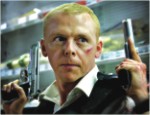 A brief cameo in Romero's eagerly anticipated Land of the Dead quickly followed, and after lending his voice to the scatological computer-animated comedy Free Jimmy, Pegg would "go-Hollywood" in a very big way by joining the Tom Cruise team in Alias director J.J. Abrams' Mission: Impossible III.
A brief cameo in Romero's eagerly anticipated Land of the Dead quickly followed, and after lending his voice to the scatological computer-animated comedy Free Jimmy, Pegg would "go-Hollywood" in a very big way by joining the Tom Cruise team in Alias director J.J. Abrams' Mission: Impossible III.
Though Pegg went on to play a substantial role in director Jean-Baptiste Andrea's Big Nothing shortly thereafter, the film was released straight to DVD in the U.S., and it wasn't until the release of Hot Fuzz that American audiences would once again get a good look at Pegg and pal Frost as they re-teamed with director Wright to parody the action-packed police thrillers that fueled their imaginations as impressionable young children.
Jason Buchanan, All Movie Guide
RS Tech Corner

By Monty Python

What's the matter? Cant run the game in your PC that you have waited the whole year round to play? The chances are, you might need to upgrade your graphics card. But then, there are also chances that you maybe still able to get the juice out of your existing card and play that game with a slightly less resolution (not fun though!). If you are short on bucks, that may be the smart thing to do. The technology that runs our gaming graphics is fast changing, what you buy today might just become obsolete within a few months. So how do you know which one to invest in. hopefully this article will help you decide.
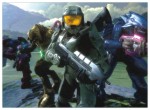 First of all you need to know the basics of a graphics card. Previously, the standard for graphics used to be an AGP (accelerated graphics port). But now all new motherboards have thrown out that standard and have the new, more faster port for plugging in your cards, called the PCI express (PCI-E). In fact, both nVidia and ATi (now owned by AMD) has stopped producing the AGP and have moved towards the PCI-E architecture.
First of all you need to know the basics of a graphics card. Previously, the standard for graphics used to be an AGP (accelerated graphics port). But now all new motherboards have thrown out that standard and have the new, more faster port for plugging in your cards, called the PCI express (PCI-E). In fact, both nVidia and ATi (now owned by AMD) has stopped producing the AGP and have moved towards the PCI-E architecture.
The technology of the cards itself has changed a lot in the last two years. Previously, the vendors would ask you how many megabyte graphics board you want. In fact, there was a time when the more RAM a card had, the more powerful it was. But now many cards have memory sharing abilities which can use your system RAM alongside the onboard RAM to show better texture. So you don't necessary need to buy a card with higher on board memory.
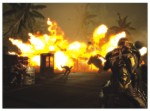 Nowadays, graphic cards have direct X certification. If I use simple terms to explain, DirectX is a Windows program that makes the games talk to your graphics card and tell them what to display. DirectX contains many instructions on displaying special effects on your monitor, and the card has to know what is written in DirectX to be able to display them. Up to now most cards supported DirectX9. but with windows Vista, DirectX 10 was released and only the most recent cards contain the information that enables them to understand these instructions. So check if you graphics cards support DirectX 10, one rule of thumb is, all nVIdia 8000 series cards and above support it. And so does all the ATI X2000 and above cards.
Nowadays, graphic cards have direct X certification. If I use simple terms to explain, DirectX is a Windows program that makes the games talk to your graphics card and tell them what to display. DirectX contains many instructions on displaying special effects on your monitor, and the card has to know what is written in DirectX to be able to display them. Up to now most cards supported DirectX9. but with windows Vista, DirectX 10 was released and only the most recent cards contain the information that enables them to understand these instructions. So check if you graphics cards support DirectX 10, one rule of thumb is, all nVIdia 8000 series cards and above support it. And so does all the ATI X2000 and above cards.
There are two more technologies called the Pixel-shader and Vertex-shader. Pixel shader is responsible for displaying all the video effects such as reflection and explosions, and Vertex shader puts colours on 3D objects based on its location on screen. At present, both of these are at version 4, but most games require that you have version 3 and most PCI-E cards are version 3 compatible. The other thing that these cards do is a feature called anti-aliasing, which smoothes jagged edges and making images look crisper, which is also very processor intensive.
So what do you do if you are unable to play a game smoothly? Remember one things, although the hype is on graphics cards, first of all you need to fulfill the basic CPU requirement for a game. Graphics cards take the load of the extra calculation and for displaying the texture, Object and some effects. But most of the calculation is done by your CPU. The higher the screen resolution you want, the more load it will have on your CPU and PCI-E card. So try lowering the resolution to 800x600 or even 640x420 if you have to. Also try lowering the anti-aliasing setting and reducing the shadows setting, that should help boost your frame rate.
In case you are simply unable to play a game or the game crashes repeatedly, try installing an updated driver. Many times I had games crashing my PC and was still able to play it just okay simply by installing a newer graphics driver or installing a patch for the game. However, if you have a really old card, then driver update or patches will not help you at all. You might just need to buy a new piece of hardware.
The prices are competitive and they tend to go down every three months. Nowadays most mother board allows you two PCI-E slots to let you use two cards at tandem, if you happen to buy a motherboard, make sure it has two slots so that you can cross link two. Right now graphics makers are concentrating on building cards that will also do physics calculations for your games. The nVidia 9000 series is out now, although you would have to sell a kidney to pay for one I bet, but by the end of the year, it would become less pricey and more available.
I hope that I was able to help you in making a good choice for a graphics card. If you have more questions, email me at [email protected].

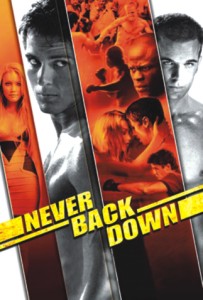
Boys want to be popular and not necessarily through cool cars, fancy gadgets and whatnot but through beating each other to a pulp. That's the basic premise of "Never Back Down" which mixes up "Karate Kid" and “Fight Club”.
The plot:
Ever since Jakes (Sean Faris) father died in a car accident, he's been moody and getting into trouble. Joining a new public school is supposed to be somewhat of a fresh start. Those troubles I mentioned included a gridiron style brawl that was caught on tape and flooded on the net. Now everyone at his new school knows what he is and why he is there.
This bad boy image gets the attention of Baja (Amber Heard), the obligatory school blonde who flirts with Jake and invites him to a party. The party takes place at some mansion where we see montages of the usual high flying rich teen parties. And in steps Ryan (Cam Gigandet) who introduces himself as the guy who runs the school combat club. Eh? What happened to simple boxing club?

He mentions how he's seen the clip and lays out an open challenge. That's when Jake realizes the blonde just played him so that he could come to the party and be part of a spectacle.
Jake refuses until Ryan talks trash about his dad. Ryan knows a lot while Jake steps up with boxing techniques and gets his bottom whopped. And then the movie goes through a training and growing up sequence for the final ultimate fight. I told you it's a bit Karate Kid.
The verdict:
While nothing out of the ordinary, it makes for a relatively fresh spin on the same old underdog story. The movie makes a moot point about boys like Jake and Ryan. Boys like to fight and they like it for the attention it brings. It may be a stupid way to go about it, but movies like the ones previously mentioned have shown that it brings in the money.
***********************************************************************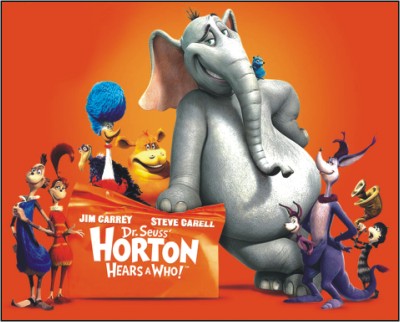
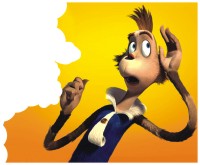 A Dr. Seuss book is something a child with an ounce of imagination will fall in love with. In fact, it is amazing just to think that someone could come up with something like green eggs and a big guy who can actually steal Christmas. It's hilarious.
A Dr. Seuss book is something a child with an ounce of imagination will fall in love with. In fact, it is amazing just to think that someone could come up with something like green eggs and a big guy who can actually steal Christmas. It's hilarious.
Sadly, the movies, while good enough on their own terms, cannot match up to the books. "How the Grinch Stole Christmas" made a splash while "The Cat in the Hat" did not. Maybe a little bit of animation would do the trick.
The plot:
The film begins similar to the book. Horton takes a dip in a pool in the jungle of Nool dictated by mob rule. There you go, a bit of Seuss for you.
A speck of something floats by and Horton hears a tiny cry for help. The speck holds a place called Who-ville and while invisible, Horton can hear its mayor. The mayor requires help and Horton jumps to the role of protector.
Of course, no one believes Horton and he goes through humiliation from the community. Who-ville of course makes enough noise to be heard but the rest in Nool don't care about the little guy.
The Mayor (voiced by Steve Carell) has plenty of character flaws that provide the actor to really flesh out the part.
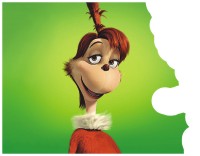 The verdict:
The verdict:
While the movie occasionally lacks humour where desperately needed, it is made up with and excellent cast of characters and the associated voice actors. We have Dr. Mary Lou LaRue (Isla Fisher) as a lisping Who-villeian. Vlad the Vulture is provided appropriate menace by Will Arnett.
Whether you ill agree or not, for a while Horton has dream sequences where the animation switches to retro 2-D style. And that seems would have made the story look and feel better than a polished shiny animated flick.
The movie sticks true to the book and provides a nice finish although you would want something like the evil kangaroo to be done away with.
